About Perch
Perch is a very widely used discipline in the field of traditional circus, but not very used in the field of contemporary circus. I can from memory name a few contemporary circus companies doing perch : Cie Barolosolo, Cirque Aïtal, Cirque Alphonse and of course Circus I love you. There are for sure more. My point is that those are the only ones I now come to think of, and I would not attempt this exercice about club juggling or pair acrobatics. It is therefore not so easy to get precise and relevant info about perch in general.
I write this article after a lot of people have asked me details about how to make a perch.
A bit of history
In 2016, Wilko Shütz student at this time in the circus department of Codarts (Rotterdam), took the assignment to research about the history of perch. He did a great job, and he allowed me to share the results here ! So for those interested about the history of perch, you should click the link and read Wilko’s work.
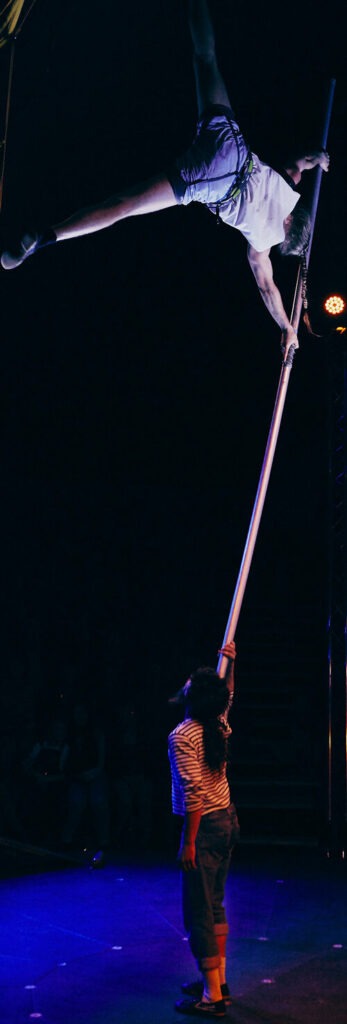
Then come some technicalities
After asking both my Mongolian perch reference (Batsugar Tsendjaev) and my Russian perch reference (Alexander Gavrilov), the answer was clear : a perch should be made out of “Dural”. But, what is dural ? It is an old name to call the alloys of aluminium used to build airplanes. In Europe these are now standardized and named by the EU norm EN 573-1. I then started to dig into the website Euralliage, where all the data of this norm about the different alloys of aluminium are clearly displayed.
The aluminium I am using is : 2017a T3 and T4. The alu 2024 was also on my list, but was harder for me to find.
The reason why “Dural” was such an unanimous answer is that the bending point of this kind of aluminium is a lot further to its breaking point than with the more common aluminiums. So practically, you will notice if you have been applying too much load to it, because it will then bend. Whereas with the common aluminiums there is a chance you might not have the luxury to see it bend before it just snaps broken (which can be deadly when it comes to acrobatics). This being said, the main contraint that would actually make a perch brake is happening when the flyer(s) center(s) of gravity goes away from the perch. For just one person doing a basic climb and staying close to the perch, I have been using a bit whatever, like a big branch, a pipe of the theater, an alu ladder, a Chinese pole… So, if you intend to do flags, spins, or all sorts of crane pieces on the top (for attaching aerials), “Dural” is my recommendation.
The calculations of the forces in the main pole of a crane are a well known thing, but these are always a function of the size and strength of the foot. In the case of the perch, the foot is supposed to have only a vertical force, and this makes this calculations impossible. I have had a couple of math and engineers geek friends to look into this problem, and they did not come to a solution for calculating properly the bending force applied to the perch while having an acrobat flagging on it. If you know better please tell me. All this to say that I will only be able to give my empirical experience for the dimensions of a perch :
With a flyer about 90kg and about 1m90 doing a flag on a 4m high perch, we use a perch in 2 pieces of 2m each made of a pipe of 50mm diameter and 2,5mm thick walls of alu 2017a T3 with a connecting piece of 45mm x 5mm of 2017a T4.
I used the same kind of pipe with the same connections to make a perch of 6m with a crane on top to make a rigging point for a rope about 50cm away from the pole. With this the flyer was about 60kg.
Here are a few things to think about when making a perch
- A pipe of 44mm x 5mm does not exist to my knowledge, and a pipe of 45mm exterior does not enter into a pipe 45mm interior (50mm – 2×2,5mm). This means that the connecting pieces should be grinded smaller by 0,5-1mm so they can fit in the pipe.
- You should use tape on the part of the connecting pipe that will be attached inside the pole, so you need to force it in. This is the best way I found to make it connect properly without having some remaining play between the two metal pieces.
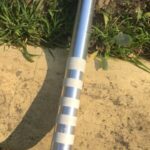
- The aluminium 2017a should not be welded (otherwise it looses its strength properties). One should use rivets to attach the connection pieces. The force applied on those rivets is minimal, and the rivets are problematic for a smooth sliding on the pole. So I use aluminium rivets of 4mm in diameter. I still use 4 of them for the sake of peace of mind.
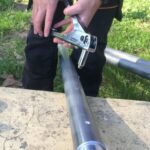
- It is good to counterbore the hole so the rivet does not stick out too much.
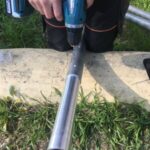
- I use connecting pieces of 50cm : 25 in and 25 out.
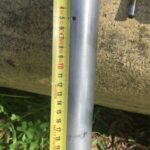
Grip or no grip?
Friction or the lack of it is always a challenge for flyers when it comes to doing perch tricks. Therefore it is always tempting to think of putting Chinese pole grip on a perch pole. I believe that the safety of the discipline lies in the capacity of the flyer to slide down as fast as possible in order to fall from the height of the base and never from the top. This explains why the traditional circus acrobats are not putting grip on the perch. Since I have an infinite respect for the practical knowledge they have, I recommend to not put Chinese pole grip on the entire pole. We are putting a bit of tissue tape on strategic places where it really feels necessary for a better grip. However, I am aware that in the contemporary circus field some people are wanting to wipe out the idea of acrobatics being always about the tension towards failure and death, and those people could plan on never performing perch without a longe. In this case, I do not see why not put the grip and make the job easier for the flyer.
The other pieces I am working with
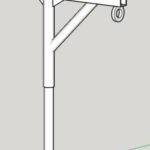
The crane piece (for aerials) made of standard alu this time because it needed welding, so it is made with quite thick pieces. I don’t have with me all the dimensions now, but if someone would want to go that path just contact me and I can make the proper drawing again.
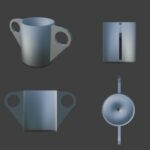
The harness piece. This is my original design, since I haven’t ever seen anyone using this. It is made of steel. I put one round sling through the side holes, I make it go around my hips and I pass an arm through each end of the sling. It makes that part of the weight is directly on the hips which makes the basing very light!
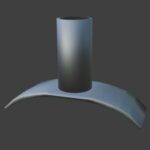
The shoulder piece. Also made of steel. Do not make it big ! it would add unnecessary weight + feed the idea that you could use the branches somehow, which is dangerous. Cover the flat with a piece of yoga mat or something similar for nicer feeling.

The handstand piece. Also made of steel. Note that the arm rest are on top of the handles forcing the flyer to slightly close the shoulders. This makes this piece into a help and the shoulder slightly close are bringing a bit of safety.
I am not going to go through anything concerning the acrobatic technique. Just contact me if you want to organise a lesson. Everyone with a real perch project is very welcome to show up in the tent of Circus I love you at any time and to train with us, would you be a young student, a professional acrobat, or an excited amateur.
I would be happy making this page more complet so don’t hesitate to get in touch with me if there would be some relevant info you would like to add.
Julien